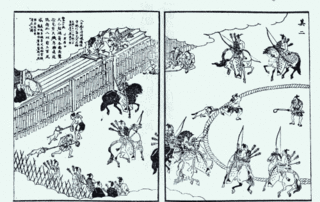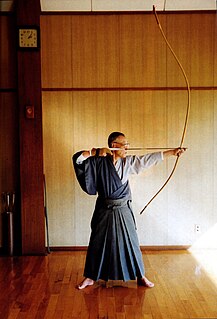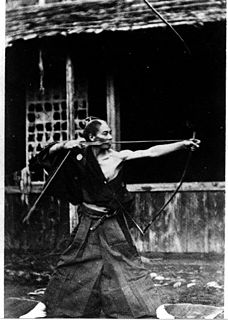 W
WInuoumono (犬追物) was a Japanese sport that involved mounted archers shooting at dogs. The dogs were released into a circular enclosure approximately 15m across, and mounted archers would fire upon them whilst riding around the perimeter.
 W
WKasagake or Kasakake is a type of Japanese mounted archery. In contrast to yabusame, the types of targets are various and the archer shoots without stopping the horse. While yabusame has been played as a part of formal ceremonies, kasagake has developed as a game or practice of martial arts, focusing on technical elements of horse archery.
 W
WKyūdō is the Japanese martial art of archery. Experts in kyūdō are referred to as kyūdōka (弓道家). Kyūdō is based on kyūjutsu, which originated with the samurai class of feudal Japan. Kyūdō is practised by thousands of people worldwide. As of 2005, the International Kyudo Federation had 132,760 graded members.
 W
WKyūjutsu (弓術) is the traditional Japanese martial art of wielding a bow (yumi) as practiced by the samurai class of feudal Japan. Although the samurai are perhaps best known for their swordsmanship with a katana (kenjutsu), kyūjutsu was actually considered a more vital skill for a significant portion of Japanese history. During the majority of the Kamakura period through the Muromachi period (c.1185–c.1568), the bow was almost exclusively the symbol of the professional warrior, and way of life of the warrior was referred to as "the way of the horse and bow" .
 W
WOn-yumishi Kanjuro Shibata XX was twentieth in a line of master bowmakers and a kyūdō teacher of the Heki Ryū Bishū Chikurin-ha (日置流尾州竹林派) tradition. Beginning in 1980, Shibata founded over 25 kyūdōjō in the United States, Canada and Europe.
 W
WThe Tōshiya or the arrows which hit the target, was an archery exhibition contest held on the west veranda of Sanjūsangen-dō temple in Kyoto, Japan.
 W
WYabusame (流鏑馬) is a type of mounted archery in traditional Japanese archery. An archer on a running horse shoots three special "turnip-headed" arrows successively at three wooden targets.